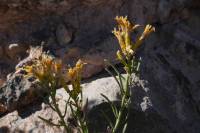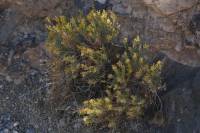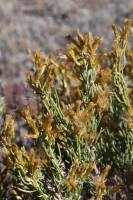Plants 30-150 cm. Stems erect to ascending, green when young, fastigiately branched, gland-dotted (in pits), resinous. Leaves mostly ascending to spreading; blades filiform (adaxially sulcate), 10-35 × 0.5-1.5 mm, midnerves obscure, apices acute to obtuse or rounded, faces glabrous, gland-dotted (in circular, deep pits), resinous. Heads in cymiform to racemiform arrays (1-3 cm wide). Peduncles 0.5-2 mm (bracts 0-3, mostly like outer phyllaries). Involucres obconic, 5-9 × 2-5 mm. Phyllaries 16-20 in 3-5 series (in vertical ranks), tan, lanceolate to oblong, 1-7 × 0.5-1.5 mm, strongly unequal, mostly chartaceous, midnerves mostly obscure, apices acute to rounded (outer each tipped with subspheric resin-gland), abaxial faces resinous. Ray florets 0. Disc florets 5-7; corollas 5.8-8 mm. Cypselae tan to brown, narrowly ellipsoid, 3-4 mm, sericeous; pappi off-white to brown, 6-7.5 mm. 2n = 18.
Flowering fall. Canyon walls, rocky flats, and slopes; 600-2400 m; Ariz., Calif., Nev.






